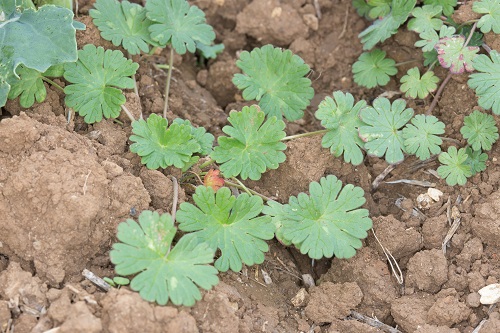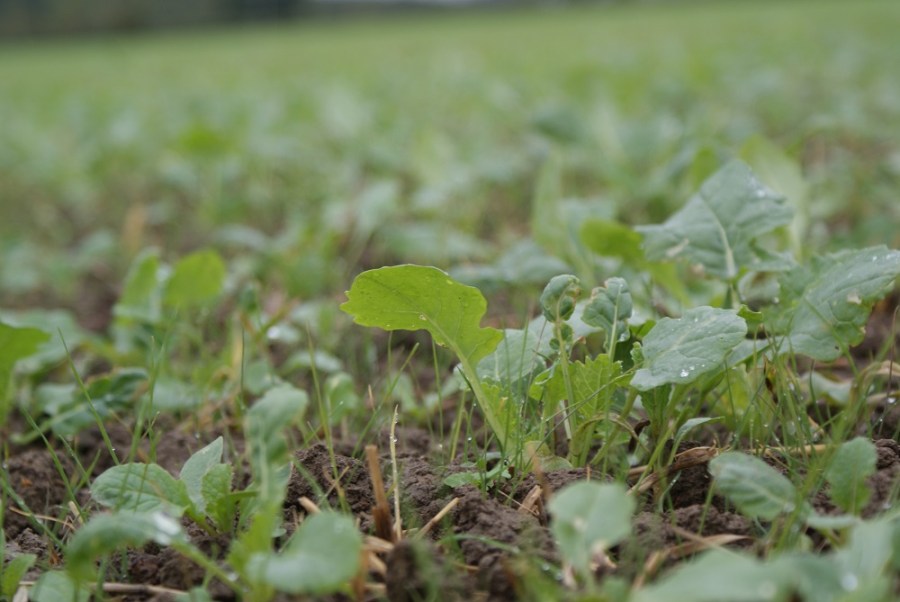The approval of a new OSR herbicide could pave the way for growers to switch from preventative to reactive autumn weed control strategies. CPM finds out how to use it to best effect.
Heavy investment in pre-em sprays is risky when you have cabbage stem flea beetle to contend with.
By Lucy de la Pasture
Establishing oilseed rape can be a risky business and this season is proving to be no exception. New post-emergence herbicide Belkar (halauxifen-methyl+ picloram) may have arrived just too late this season to benefit many growers, but those that have already gained some experience using it are poised for a shift in their herbicide strategy.
Both of the active ingredients in Belkar are already familiar to arable growers, with Arylex Active the key molecule in cereal herbicides Pixxaro (Arylex+ fluoroxypyr) and Zypar (Arylex+ florasulam), and picloram, known to growers as one of the actives in spring-applied OSR herbicide, Galera (clopyralid+ picloram).

One of Belkar’s key strengths is on cranesbill, a weed most other herbicides miss.
Targeting cleavers, cranesbill, poppy, shepherd’s purse and fumitory, Belkar offers an alternative to the traditional pre-emergence sprays. Instead, growers can wait until the crop is out the ground – giving themselves time to assess the visible weed pressure plus the impact of cabbage stem flea beetle and slugs.
This year is a good case in point, says Agrovista’s technical manager, Mark Hemmant. “Warm, dry soils have provided good conditions for the pest and poor conditions for the crop, leaving flea beetles happily munching away.”
And it’s that very real risk of crop failure with OSR that makes growers reluctant to fork out on pre-em herbicides. For this reason, the approval of a new post-em herbicide will provide a new option for growers, comments Mark.
“As well as the cost involved, use of a pre-em can limit following crop options in the event of a crop failure.” he adds.
Andrew Cragg from 600ha Brooker Farms on Kent’s Romney Marshes held product trials through the winter of 2017 and says the chemistry will lead to a change of approach. “There’s very little chemistry in the armoury that will control all of the problems we have in the OSR crop,” he says.
“Cranesbill, chickweed, blackgrass and volunteer cereals are what I’m looking to deal with, and that has typically taken applications of clomazone or a pre and post-emergence spray of metazachlor. That would be followed by propyzamide and aminopyralid. It’s become a real task to get to grips with everything.”
Andrew says he’s got used to front-loading his herbicides but that the strategy is ‘risky because you don’t know if the crop is going to arrive.’
“I have seen the trials demonstrate very good control of cranesbill and cleavers and it means I can deal with them once the crop is up. I’m happy to invest if I know it’s going to have an output and I think other growers will have no problem moving to a post-em regime if that means they don’t have to invest in a crop that they don’t know will be there.”
Peter Waite, national account manager at Corteva, says a product with Belkar’s properties has been demanded by the market for some time.
“We first got approval for Arylex in cereals in 2015 and when agronomists saw that it controlled cleavers and cranesbill but not brassicas, the question quickly came about when it would be available in OSR.
“Now it has approval, we think it will be at the forefront of growers’ minds in the future because heavy investment in pre-em sprays is risky when you have cabbage stem flea beetle to contend with and, in a wet autumn, slugs.”
There are three treatment options which Corteva says have performed best in trials.
“At two true leaves an application at 0.25 l/ha will take out the weeds which have germinated alongside the crop and, in some circumstances, that will be enough broadleaf weed control before an application of Astrokerb (propyzamide+ aminopyralid) or similar later on.
“In high weed pressure situations where you get a second germination you can do a second 0.25l/ha two-to-four weeks after the first.
“A third option where you have a low-pressure situation is to wait until six true leaves of the crop and apply 0.5 l/ha which will take care of the weeds going into the autumn.”
Mark believes the best approach is using the split dose and Agrovista trials have demonstrated that the addition of Parish (phenmedipham) at the two true leaf stage of the crop is worthwhile to broaden the weed spectrum.
“We’ve seen significant improvements in the control of chickweed, speedwell and groundsel and poppy, particularly when it has become larger than ideal (<2cm). Parish needs sunny conditions at the time of application so it’s best suited to the early timing and the mix is supported on the product label,” he adds.
One of the main strengths of Belkar is its activity on cranesbill, a weed other OSR herbicides struggle to control. “Fox (bifenox) has an EAMU for control of Geranium sp. in OSR after the six true-leaf stage of the crop but control tends to be variable,” he comments.
Cranesbill is mostly a heavy land weed so often occurs hand in hand with blackgrass, adds Mark. “Ideally a pre-em of metazachlor would be an advisable strategy but if there’s a reluctance to spend at that timing then Kerb (propyzamide) will help catch grass weeds later on.
“With graminicide Centurion Max (clethodim) and Belkar both having a label recommendation to apply from the two true leaf stage of the crop, the biggest thing to consider is sequencing them. Centurion Max needs two clear weeks either side of application and must be applied by 15 Oct,” he points out.
“Belkar can be applied from 1 Sept until the end of Dec but in most situations grassweed control will take priority, unless cranesbill is the over-riding problem.”
Peter adds a full launch of Belkar will take place ahead of 2019 applications because its approval was granted too late in the day to supply product in any quantity this autumn.
Spotting light leaf spot
The rise of light leaf spot (LLS) in the southern parts of Britain means the disease has become a priority to most growers, not just those in the North where the disease has historically been a problem. Last season Bayer, in conjunction with ADAS and supported by the AICC, introduced a new LLS testing service called SpotCheck.
Unlike some crop diseases, LLS can spread quickly because the disease is polycyclic, which means that several infection cycles can take place in a growing season. Initial infections start in the autumn from spores released on air currents from infected trash, then rain-splashed spores are produced in multiple cycles, infecting other plants, explains ADAS plant pathologist Philip Walker.
“LLS is potentially always cycling – it’s releasing spores and that can produce new infection,” says Philip. “So that makes it very difficult to control, because you get one application on and that will control that cycle of it, but if there’s anything surviving that can still cycle, you’ll get another load of it.
“This year there was a period, around the end of March, where there were a couple of weeks of heavy rainfall. And from that, the amount of LLS rapidly developed.”
Early detection in crops has to date relied on incubating leaf samples in a plastic bag placed in a warm place, such as the airing cupboard. SpotCheck takes the same principle a step further and has given a picture of how the disease is developing nationwide. 600 samples have been analysed in its first year, giving further information on other foliar diseases that may also be present.
During the five months that SpotCheck ran, weekly assessments were also carried out by ADAS on untreated plots of OSR in Herefords and Yorks. Plants were visually assessed for LLS in the field, leaf samples were then incubated for 48-hours and re-assessed. The results highlighted regional differences in LLS pressure, explains Bayer’s Claire Matthewman.
“At High Mowthorpe in North Yorks, symptoms were seen after incubation by 13 Dec, but visible signs could not be seen in the field until 17 Jan. By mid-March, more than 80% of the crop had symptoms after incubation, but only around 30% had symptoms that could be seen in the field.”
Meanwhile at Rosemaund symptoms of LLS could be seen after incubation as early as 30 Oct, but couldn’t be visually identified in the field until 15 Jan.
“This represents an 11-week period during which the disease was present and could spread through the crop. By the end of Feb, 100% of the samples were infected after incubation, but 15% of plants appeared symptomless in the field.
“This period when infection is present and no symptoms are visible in the field, could see growers missing a vital window to spray and would give the fungus the chance to release more spores,” comments Claire.
Philip points out the most important thing for controlling LLS is the spray timing. Waiting for visual symptoms of LLS to appear in the field may mean missing an early opportunity to spray before the disease takes hold.
“You need to get it as close as possible to when you first become aware of the signs of infection,” he says.
Chris Eglington, director of SS Eglington & Son in Thetford, Norfolk, used SpotCheck in Oct and Nov last year and then again in Feb 2018. His own visual inspection of his OSR crop hadn’t picked up any problems but he wanted to utilise SpotCheck in order to get a more detailed analysis.
Around 20% of his OSR had LLS on each occasion, with phoma and powdery mildew also detected in Nov.
“Light leaf spot has been around here for about three years now. But it’s really caught the imagination of everybody in the past year and a half,” he says. “I was surprised about the results in the sense that you couldn’t really see much in the field. But obviously SpotCheck did pick up some problems I hadn’t seen.”
He sprayed with Proline (prothioconazole) and tebuconazole before Christmas. “We always put on a fungicide in the autumn, but last year we applied two. Proline is the one we generally use and then we also used tebuconazole, which is a bit of a crop shortener as well.
“We followed with two sprays in the spring to cover a fairly broad spectrum of disease. With most chemistry nowadays, prevention is better than cure. If you’ve got a good crop in the autumn you protect it because you know you have potential for a good yield.”
Chris also found SpotCheck useful for determining which varieties would be more suitable for future planting. Of the two OSR varieties he was growing, Barbados and Elgar, the former was noticeably more resistant to LLS, in spite of both being rated as 7’s on the AHDB Recommended List.
“Sending samples to SpotCheck, or incubating leaves yourself, will potentially allow you to see whether an earlier treatment is required,” adds Claire. “This will give you a much better chance of controlling the disease for the rest of the season. If you don’t act until early spring when LLS is in its later stages, fungicide treatments won’t be as effective.
SpotCheck will be available again for the 2018/19 season www.cropscience.bayer.co.uk/spotcheck




